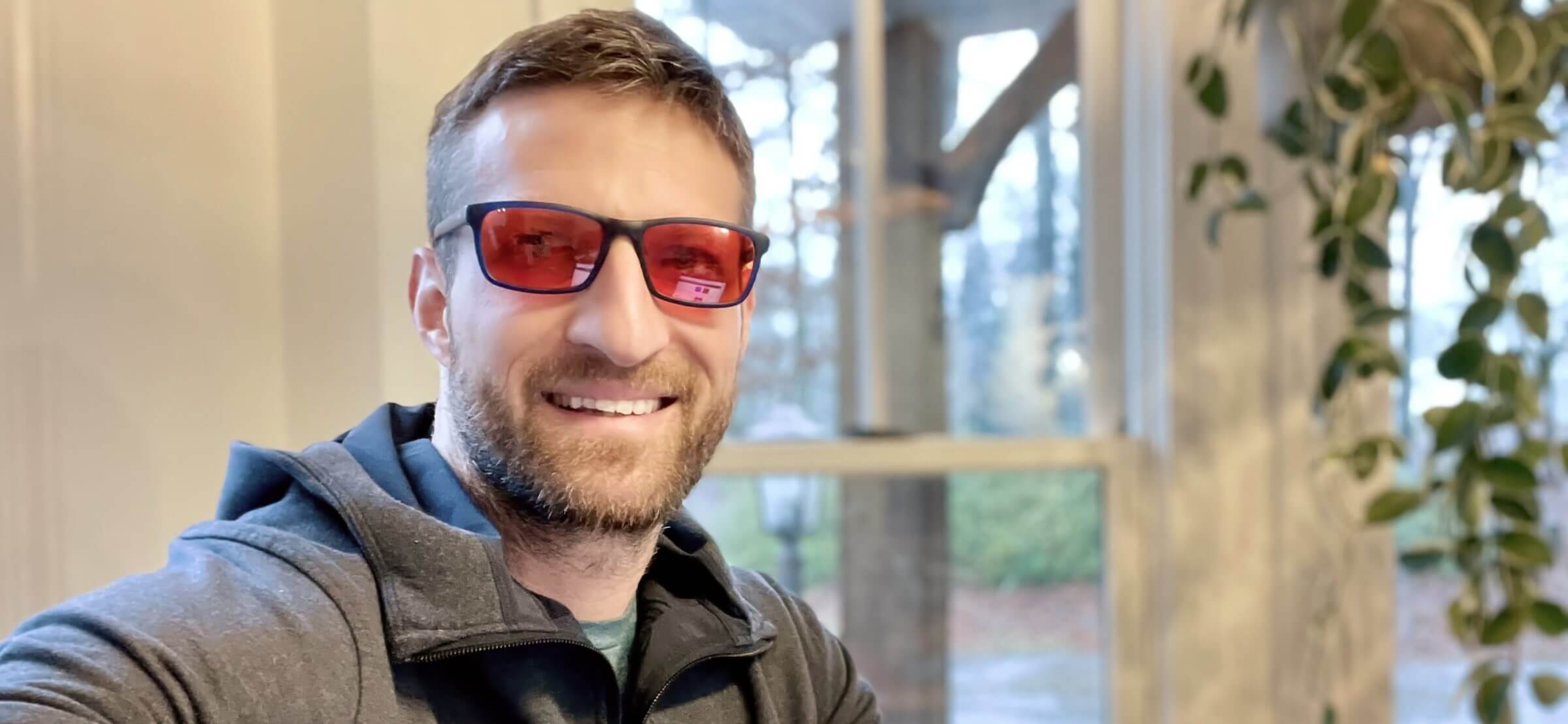Blue light glasses offer several scientifically-proven health benefits, including reduced eye strain and improved sleep quality. In addition, research has shown that blue light glasses can be an effective intervention for mood disorders such as manic symptoms and bipolar disorder.
However, it’s important to understand that not all blue light glasses provide equal benefits. The color and quality of the lenses determines how well blue light glasses work, and many of the lower-end products available on the market provide essentially no benefits at all.
This article explains the key aspects of how light interacts with the body, as well as the science behind the four most valuable benefits of wearing blue light blocking glasses.
I’ll also tell you about my experience with blue light blockers, including why I ditched the cheap pair I bought off Amazon in favor of a much more expensive (but effective) pair from a company called BON CHARGE.
Why Blue Light Affects Our Sleep
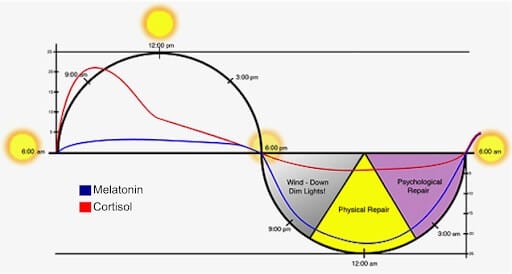
Each cell in the human body has a biological clock that governs how the cell operates. Scientists call this phenomenon the circadian rhythm, and it has evolved over millions of years in close relationship with the timing of sunrise and sunset.
What that means is that many of the chemical processes in the human body — including the release of cortisol in the morning and the release of melatonin in the evening — are closely connected to the presence of light (or lack thereof).
In fact, science has now shown that certain frequencies of light can either support or impair the release of particular hormones. For example, we know that green and blue light in the spectrum of 400-550 nm (even if it’s dim) can negatively impact the release of melatonin.
In the past, that wasn’t an issue because these light frequencies do not occur in nature after sunset. But in modern society, we’re exposed to these frequencies at all hours, thanks to the light-emitting diodes (LED lights) and electronic devices that we surround ourselves with.
In case you’re wondering, neither fire nor candlelight emit those sleep-disrupting frequencies, so the discovery of how to make fire about 2 million years ago didn’t change how humans responded to light after sunset.
The Health Benefits of Blue Light Glasses

Depending on their lens color, blue light glasses block none, some, or all of the frequencies associated with blue and green light, thus preventing those sleep-disrupting frequencies from reaching your retina.
As such, wearing blue light blocking glasses can:
- Support your circadian rhythm.
- Improve your sleep onset and quality.
- Reduce eye strain (aka computer vision syndrome).
- Serve as an effective intervention for mood disorders (e.g., manic symptoms or bipolar disorder).
Depending on what benefit you’re looking to achieve, and to avoid negatively impacting your circadian rhythm, you have to pick the correct lens color.
| Lens Color | When to Wear |
|---|---|
| Transparent: | During the day, when exposed to artificial light (e.g., digital screens). |
| Yellow: | During the day, when you suffer from light-sensitivity issues. |
| Orange or red: | After sunset. |
So let’s talk about the top benefits of blue light glasses in more detail and discuss how lens color plays into each.
1. Supports Your Circadian Rhythm
As we discussed above, certain light frequencies directly impact the circadian rhythm and the release of hormones in the morning and the evening.
For example, frequencies that make up blue and green light can signal your body that it’s time to wake up and crank up the engine. While that’s beneficial in the morning, it’s counter-productive when you’re trying to fall asleep.
By wearing blue light glasses with orange lenses after sunset, you can prevent those up-regulating frequencies (from artificial light sources) from reaching your retina, thus enabling your body to wind down and release sleep-inducing hormones.
However, it’s worth mentioning that you can also disrupt your circadian rhythm by wearing blue light glasses with the wrong lens color during the day.
In other words, don’t use orange lenses before sunset, because blocking all blue light during the day sends the body the wrong signals.
2. Improves Sleep Onset and Quality
Tied to their ability to improve your circadian rhythm, blue light glasses can help you fall asleep quicker (i.e., improve sleep onset) and sleep better. That’s because blocking all blue light after sunset and before bedtime allows the body to make and release enough melatonin to help you fall asleep and spend more time in slow-wave (deep) sleep.
For example, a review conducted by researchers at the University of Oklahoma College of Medicine found that:
“Out of the 24 publications focusing on sleep, there was substantial evidence for blue-blocking glasses being a successful intervention for reducing sleep onset latency in patients with sleep disorders, jet lag, or variable shift work schedules.”
Improving sleep onset and quality is the main reason why we leverage blue light glasses in the Kummer household, especially while traveling and after disruptions to our normal sleep routine.
3. Reduces Eye Strain
Blue light has a relatively short wavelength, which causes a slight focus shift from the center of the retina to the front of the retina. If you’re exposed to such a focus shift for extended periods (e.g., while working in front of a computer all day), you might experience a worsening of visual fatigue or eye strain, as well as nearsightedness.
By blocking some (but not all) of those blue light frequencies using glasses with clear or yellow lenses, you can effectively reduce eye strain.
4. Effective Intervention for Mood Disorders
Many people don’t realize how impactful light is on our health and well-being. While natural sunlight is often considered healing and rejuvenating, certain frequencies of blue light can negatively impact those who suffer from certain mood disorders.
Blocking the offending frequencies of blue light can help improve the symptoms of such mood disorders.
For example, a study published in the journal Chronobiology International found evidence that blue light blocking glasses can be an effective intervention for manic symptoms and bipolar disorder.
Despite the study’s findings, I don’t recommend avoiding natural sunlight if you suffer from a mood disorder (I’d increase my exposure), but rather that you leverage blue light glasses to block artificial junk light from reaching your eyes.
How Not to Use Blue Light Blocking Glasses

When I first started my journey with blue light blocking glasses, I didn’t know how to correctly use them. So I bought what turned out to be a pair of computer glasses, and I wore them after sunset.
Unsurprisingly, my glasses had no impact whatsoever on my sleep quality or sleep onset. That’s why I stopped wearing them.
The lesson I learned from that experiment was to select the right type of blue light filtering glasses for what you’re trying to accomplish.
In other words, don’t wear computer glasses after sunset (because they won’t work). And don’t wear glasses that block 100% of green and blue light while the sun is out (because you need blue light exposure during the day).
Doing so would have unintended side effects, such as lower energy levels during the day due to a disrupted circadian rhythm.
Benefits of Blue Light
While exposure to blue and green light after sunset can negatively impact your health and well-being, you want to expose yourself to those frequencies as soon as the sun rises.
That’s because exposing your naked eyes to early-morning sunlight supports healthy cortisol levels, which helps you maintain optimal energy levels throughout the day.
If natural sunlight isn’t an option (or on days the sun is hiding behind clouds), you can leverage artificial sources of light, such as a red light therapy panel.
I’m not saying to expose yourself to artificial light all day, but you should definitely be exposed to many of the frequencies that make up sunlight during the day.
My Experience with Blue Light Blocking Glasses

Considering that many of us have high exposure rates to certain frequencies of light (emitted by artificial sources of blue light) during the day, as well as after sunset, it makes sense to limit blue light exposure and mimic that of natural sources.
That makes the case for wearing blue light or blue light blocking glasses after sunset and, in some cases, even during the day — if you suffer from digital eye strain, for example.
I work from home, and my office has three large windows that let in sufficient amounts of natural light. Additionally, I’ve configured my computer screen to automatically turn on Night Shift between 5 a.m. and 7 p.m.
Night Shift is supposed to make the color temperature of your Mac’s screen warmer (by removing some of the blues) after sunset. But it does such a poor job at filtering out blue and green light that it’s not worth using it for that purpose.
However, it does do a reasonable job of filtering out some of the blue light frequencies that might cause you issues during the day, such as digital eye strain, eye fatigue, dry eye or headaches.
By exposing myself to enough natural light, combined with enabling Night Shift on my Mac during the day, I don’t have to worry about wearing blue light blocking glasses with transparent lenses (also known as computer glasses).
However, I noticed a dramatic impact on how fast I fall asleep and the quality of my sleep after I started experimenting with blue light glasses. For example, after wearing my BON CHARGE glasses for a few days, I began noticing how sleepy I’d feel close to bedtime. Previously, I had only felt like that while supplementing with melatonin. That was a clear sign that my body was doing what it was supposed to: release sleep-inducing hormones, including melatonin.
It was also a sign that I wasn’t disrupting that process by bombarding myself with wavelengths of light that wouldn’t occur in nature after sunset. As a result, I would fall asleep quicker and get more slow-wave (deep sleep) every night.
Most deep sleep occurs in the first half of the night (as opposed to REM sleep, which occurs predominantly in the second half of the night). So anything you can do to help your body fall asleep quicker and to stay asleep during the first couple of hours usually leads to more deep sleep.
As you might know, deep sleep supports physical recovery and the release of critical hormones, such as human growth hormone (HGH). I’ve noticed that when I get enough restorative sleep (deep and REM sleep), I’m less sore the next morning (even after intense CrossFit workouts).
That said, the demands of my physical performance aren’t the only reason why I’m continuously trying to improve my sleep. Like most people I know, I have a relatively stressful life that requires me to split my attention between this blog, family, friends, pets, my supplements business and my hobbies. The only way for me to stay sane and avoid being overwhelmed is to maintain a lifestyle that properly supports both my body and mind. Good sleep is at the very foundation of that lifestyle.
Other Ways to Block Blue Light
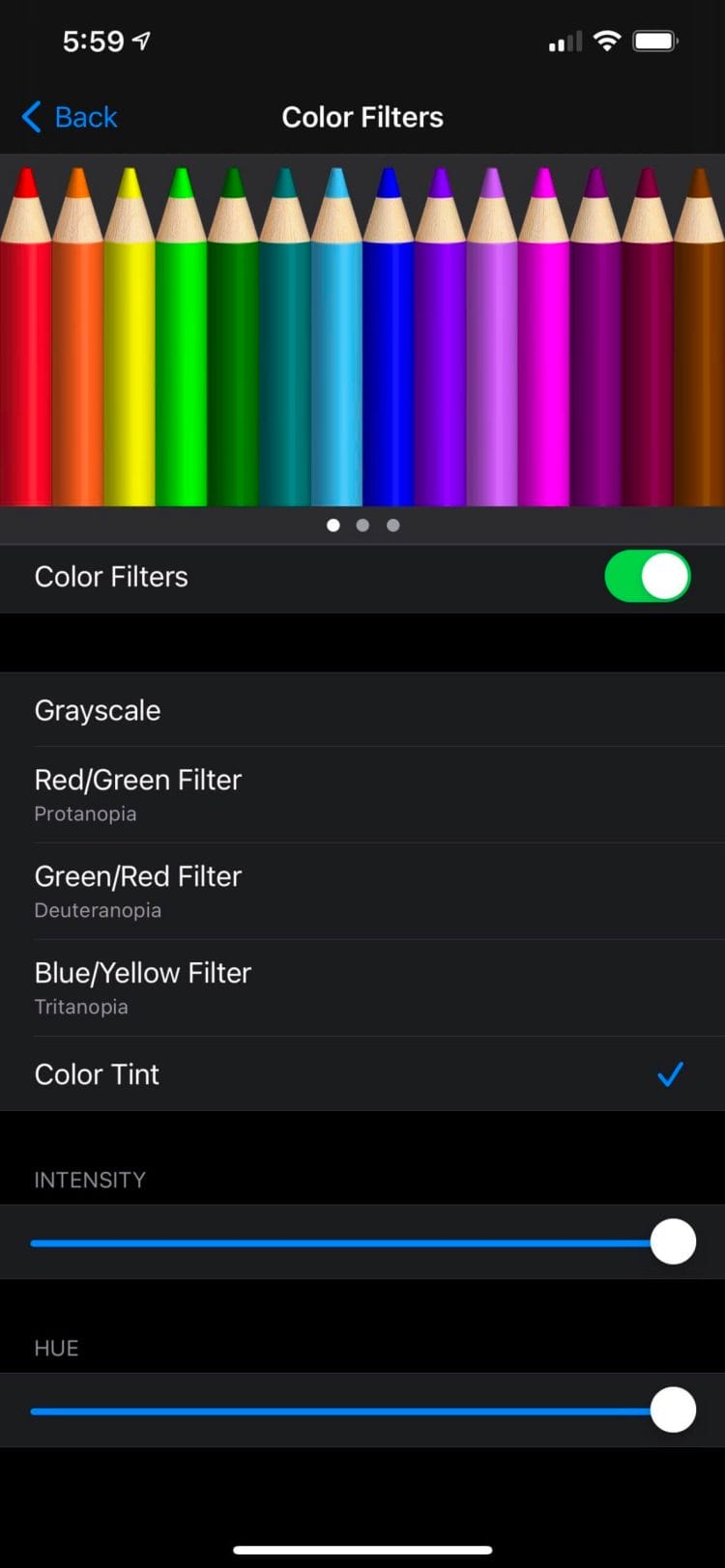
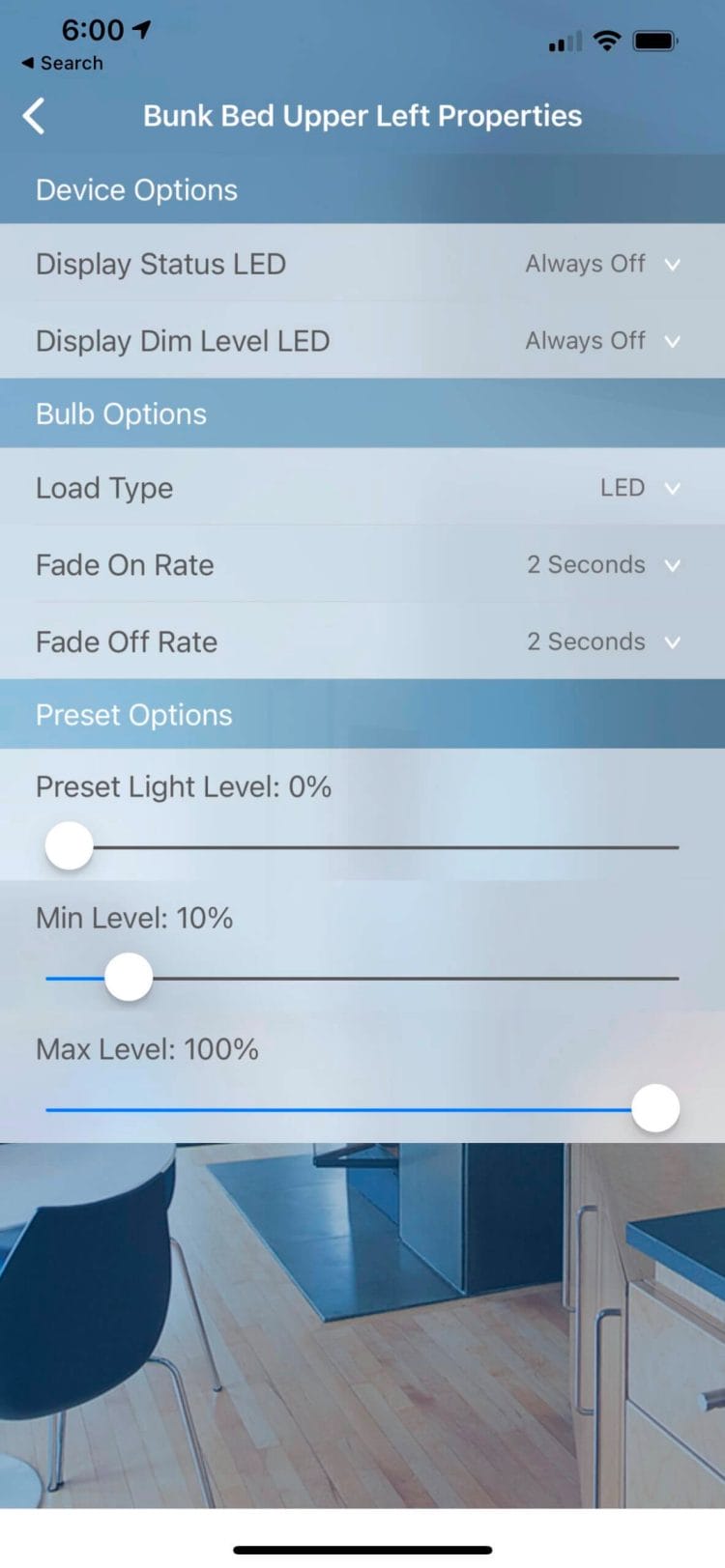
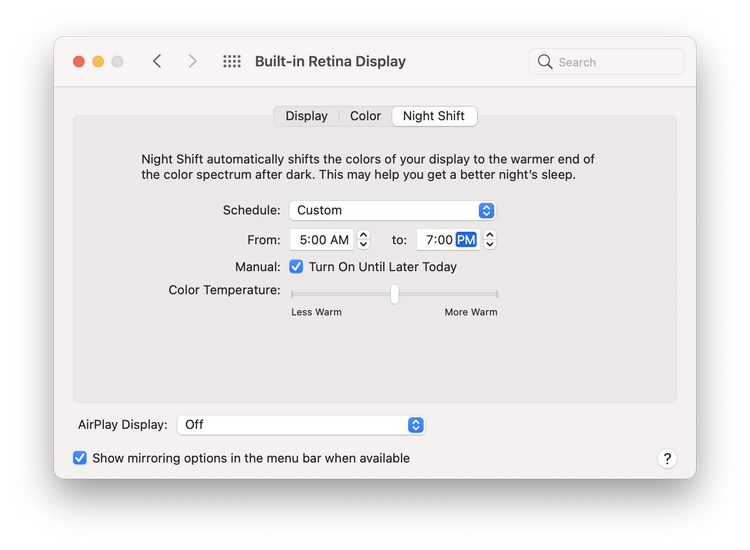
If you want to block artificial blue and green light, wearing the appropriate eyewear is an excellent first step. However, there are other things you can do to reduce your exposure to certain unnatural wavelengths of light.
Below are some of the steps we’ve been implementing at the Kummer household:
- Turn off (or tape over) status LEDs of electronic devices and light switches.
- Use candles instead of lightbulbs after sunset.
- Limit your screen time on digital devices after sunset.
- Turn on Night Shift on your Mac during the day.
- Turn the screen of your iPhone red after sunset (see the FAQ section below for a guide on how to do this).
One of the first things we did in our bedroom is turn off or tape over the status LEDs of all our light switches, phone chargers and other electronic devices.
For our HomeKit-enabled Leviton smart switches, I was able to use the app to turn off the status LEDs. For the dimmer switch that controls the ceiling fan, I had to use tape because Lutron doesn’t offer a setting to turn off the LED. I used the same tape for the wireless charging pad my wife uses to charge her iPhone and Apple Watch overnight.
The next thing I did was configure my iMac to automatically turn on Night Shift at sunrise. That reduces my exposure to certain unnatural frequencies of blue light during the day.
Additionally, I used an accessibility setting on my iPhone to turn the screen red after sunset.
The last thing we’re still working on is better leveraging candles instead of artificial sources of light after sunset.
The reason why we haven’t pulled that trigger yet is that most candles are made with unhealthy ingredients that are estrogenic, and pure beeswax candles are relatively expensive. Since first publishing this article, we’ve made several candles from the wax we harvested from our beehives. Unfortunately, we only have a couple of hives and don’t get enough wax to make all the candles we need.
How Your Skin Absorbs Blue Light
You may wonder why we even bother with reducing our exposure to blue light in our home if we can just wear blue light blocking glasses after sunset.
One reason is that my past experience has shown that our kids aren’t as disciplined about putting on their glasses as we are.
The truth is that I don’t want our kids to be burdened by all the modern lifestyle issues that my wife and I worry about every day. It’s our job to protect them from all of that crap, and I prefer to cultivate an environment that’s conducive to their health rather than put a responsibility on their plate that they’re too young to fully understand.
Additionally, our eyes are not the only way our bodies absorb blue light. Our skin also absorbs it.
The good news is that blue light absorbed by your skin doesn’t negatively impact sleep. However, shining fluorescent blue light (the type common in office buildings) on your skin may increase your risk of skin cancer.
That’s why we’ve been trying to limit our exposure to blue light after sunset, regardless of the use of blue light glasses.
Frequently Asked Questions
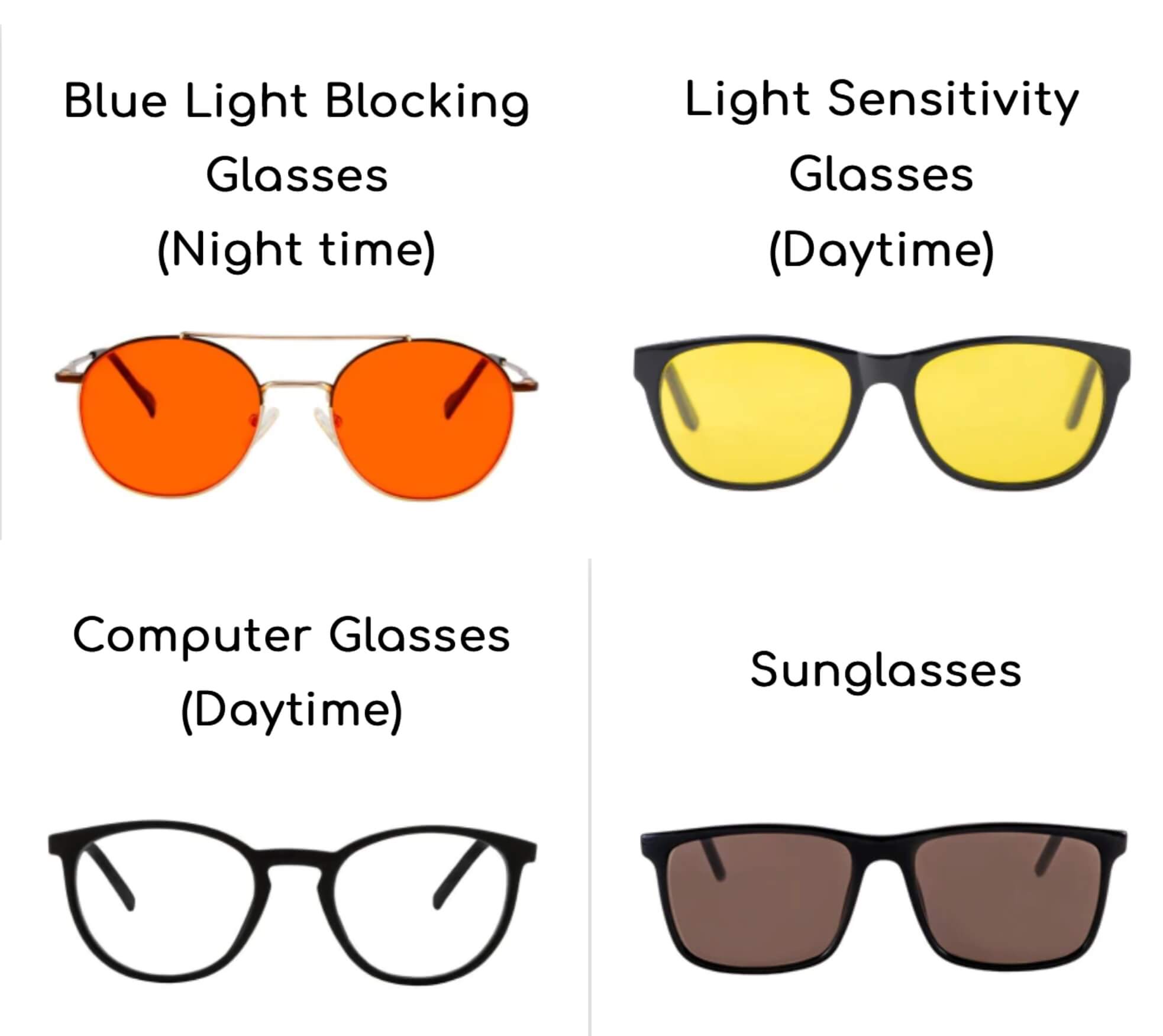
Yes, blue light glasses that block the correct frequencies of blue and green light do work by supporting your circadian rhythm. Within two days of wearing the glasses from BON CHARGE, I noticed that I was getting very sleepy right before my usual bedtime — comparable to how I would feel after taking a low dose of melatonin.
If you’re exposed to a lot of blue light frequencies from artificial sources that trigger health issues — such as digital eye strain, headaches or migraines — then wearing computer glasses that filter out some of those offending frequencies can help.
However, don’t wear blue light glasses that block out all the light between 400-550 nm (the melatonin disruption zone) during the day. If you do, you’ll be sending the wrong signal to your body.
You need to expose yourself to the frequencies of light that the sun emits during the day for your body to function optimally.
Blue light blocking glasses are available in different colors, as you can see in the table above.
Besides computer glasses and blue light glasses with red/orange lenses, there are a third type of glasses you could consider wearing: blue light glasses with yellow lenses that are meant to be worn during the day by people who suffer from severe light sensitivity issues, such as anxiety, depression, migraines or seasonal affective disorder.
Since I don’t suffer from any of those issues, I have never tried yellow glasses and can’t comment on their effectiveness.
As you may have already guessed, transparent lenses filter out the least amount of blue and green light, followed by yellow lenses. Only high-quality orange or red lenses can block out all the wavelengths in the 400-550 nm spectrum.
You can wear computer glasses during the day and orange glasses (that block 100% of the light between 400 nm to 550 nm) after sunset. I use the Rise app to remind me to put them on at the start of my “melatonin window” — the time during which my body produces the most melatonin.
No, unfortunately neither Dark Mode nor Night Shift blocks enough blue light to make a difference after sunset. However, you can use those features to reduce your exposure to artificial blue light during the day. To prevent your iOS device from emitting blue and green light, you have to use a color filter to turn the screen red (see below).
In iOS, you can turn the screen red by applying a color filter.
To do that, go into Settings > Accessibility > Display & Text Size > Color Filters and select Color Tint.
Slide both the Intensity and Hue sliders all the way to the right.
That will turn your screen red and make it safe for use after sunset.
To make it easier to turn on the color filter without having to dig through the settings, you can use the Accessibility Shortcut (triple-click on the side button).
To turn on the shortcut, go to Settings > Accessibility and scroll down to “Accessibility Shortcut” where you can select “Color Filters.”
Once enabled, you can triple-click on the side (power) button to enable or disable the color filter.
I’ve tried to create a Siri Shortcut to turn the screen of my iPhone 12 Pro Max red every night at sunset, but Apple doesn’t support that yet.
For the most accurate results, you’d have to use a spectrometer to determine what light frequencies your glasses let pass through the lens. Alternatively, you can ask the manufacturer of your glasses for a light spectrum report.
If you don’t trust the manufacturer’s claims (or simply want to verify them), you can perform the following tests at home.
For computer glasses, see what color the light is that gets reflected off the lenses. If it’s blue, your glasses are blocking at least some of the correct frequencies. If your glasses come with a “pen tester,” make sure the pen actually emits blue and not purple light.
For (orange) blue light glasses, you can do a color test such as the one offered here. These tests aren’t 100% accurate, but they’re a good starting point that can help you weed out any ineffective glasses.
Melatonin is great for traveling and for helping you to adjust your circadian rhythm. The problem is that it can be habit-forming, and it might make your body stop producing its own melatonin.
The body is a complex piece of machinery that tries to keep everything in perfect balance. So when you use exogenous hormones (be it melatonin, testosterone or others), it reduces the amount of these hormones it makes on its own — or it stops their production entirely.
That’s why I recommend refraining from using melatonin over long periods.
Yes, I believe blue light blocking glasses can help maintain good eye health. Both epidemiologic and experimental evidence and rodent studies suggest that blue light-blocking lenses could theoretically benefit patients with age-related macular degeneration, and we also know that certain blue light frequencies can contribute to cataracts. As a result, I consider blue light glasses a valuable tool in my eye care regimen.
If you play video games during the day, you can wear computer glasses. If you play after sunset, yellow lenses are probably your best option because orange lenses are too dark to play video games.
Yes, you can combine contact lenses with regular (non-prescription glasses), or use prescription lenses instead of your contacts.
Unfortunately, it doesn’t take much blue light to negatively impact your circadian rhythm and sleep. Even a small amount of blue light emitted by the status LED of your television can impact your sleep.
Windows 10 and later offers a blue light filter, similar to Apple’s NightShift on Macs. However, much like Apple’s implementation, the blue light filter on Windows doesn’t remove all of the short wavelengths required to be effective. That said, if you want to find out how to enable the blue light filter on Windows, you can check out this article.
The blue light blocking glasses I have still allow some light to reach my eyes, especially if I look up, down or to the side. So the question is whether this peripheral light can impact the release of melatonin.
The short answer is “no,” peripheral light isn’t a big concern.
The intrinsically photosensitive retinal ganglion cells (ipRGCs) — also called photosensitive retinal ganglion cells (pRGC), or melanopsin-containing retinal ganglion cells (mRGCs) — are located in the inner retina and function in such a way that the extremely minor light that may peek through the sides or the top of the frame is not enough for the pupillary light reflex (PLR) to phototransduct to any large degree, because the iris is open to a wider diameter due to the lenses themselves already producing a dynamic reduction in light volume.
In plain English, that just means it’s a matter of light angle.
Scientists have discovered that red light exposure in the evening can promote good sleep by increasing melatonin levels. So if you have a smart bulb, you could consider turning it red after sunset to help promote good sleep.
Wrap-Up: Why You Should Consider Getting a Pair of Blue Light Glasses
Unless you’re willing to live a truly Paleolithic lifestyle that excludes the use of artificial sources of light, you’ll have to deal with managing your exposure to certain light frequencies after sunset. That is, if you want to give yourself the best chances of sleeping well.
As a result, I consider blue light glasses a valuable tool in my toolkit to help me to optimize my health and well-being, and I regularly wear a pair that I purchased from BON CHARGE.
My wife asked me the other day if I’ll be wearing those glasses for the rest of my life, and my answer was “no.” Instead, I wear them “on demand.”
In other words, as long as my circadian rhythm works well, I fall asleep quickly, sleep well and wake up rested, I don’t wear blue light blocking glasses. But as soon as I feel like my circadian rhythm is off, I start wearing them again.
That’s particularly true in the spring and in fall, when we change the clocks.
Additionally, I always aim to reduce our overall exposure to blue light after sunset as much as possible by disabling and taping off status LEDs and by leveraging candles instead of artificial sources of light.
As with everything else, I recommend taking small steps to tackle the lowest-hanging fruits first. Don’t stress out over every detail in an attempt to make it perfect. That creates unnecessary anxiety that’s just as unhealthy as your exposure to blue light.

Michael Kummer is a healthy living enthusiast and CrossFit athlete whose goal is to help people achieve optimal health by bridging the gap between ancestral living and the demands of modern society.
Medical Disclaimer
The information shared on this blog is for educational purposes only, is not a substitute for the advice of medical doctors or registered dieticians (which we are not) and should not be used to prevent, diagnose, or treat any condition. Consult with a physician before starting a fitness regimen, adding supplements to your diet, or making other changes that may affect your medications, treatment plan or overall health. MichaelKummer.com and its owner MK Media Group, LLC are not liable for how you use and implement the information shared here, which is based on the opinions of the authors formed after engaging in personal use and research. We recommend products, services, or programs and are sometimes compensated for doing so as affiliates. Please read our Terms and Conditions for further information, including our privacy policy.
